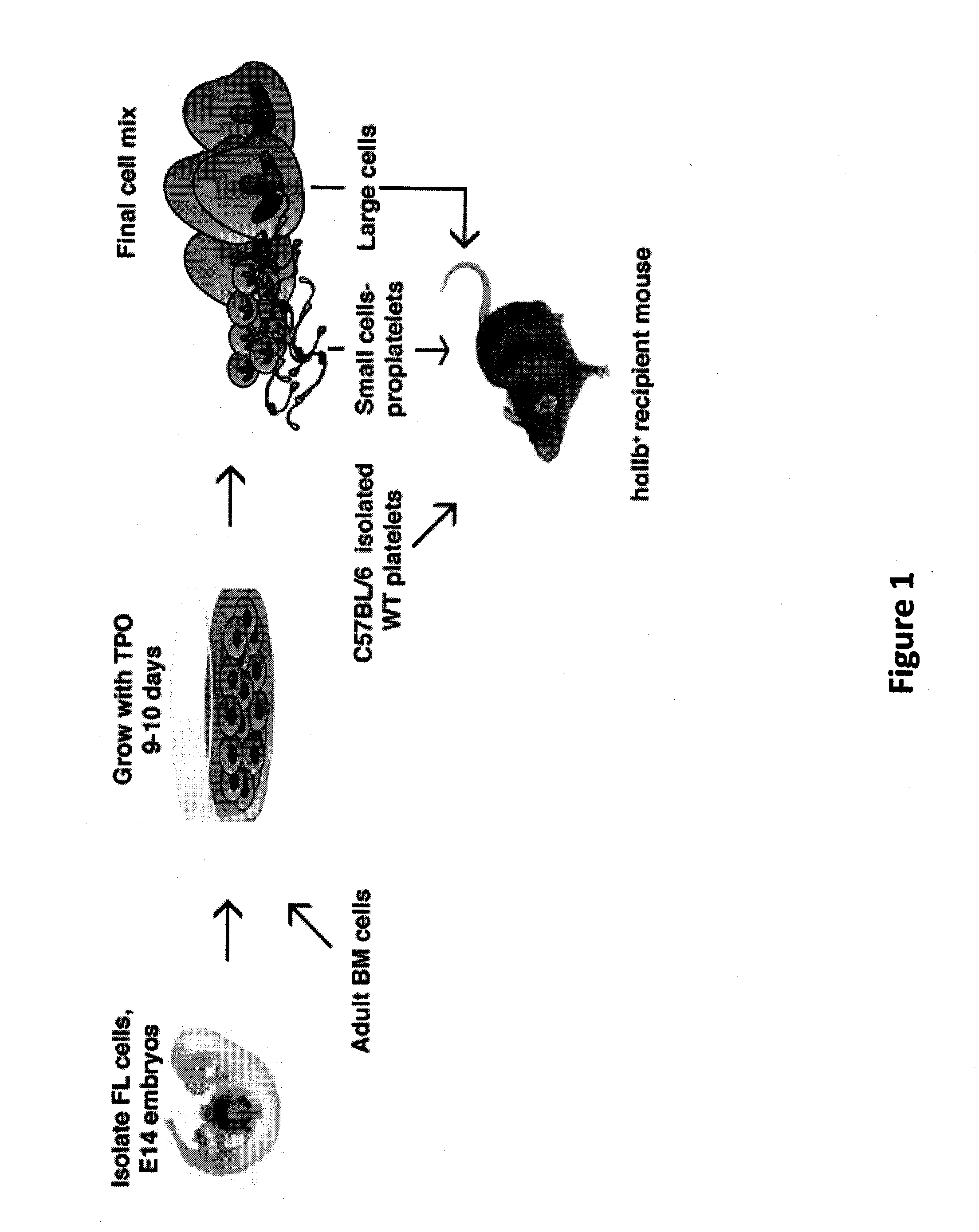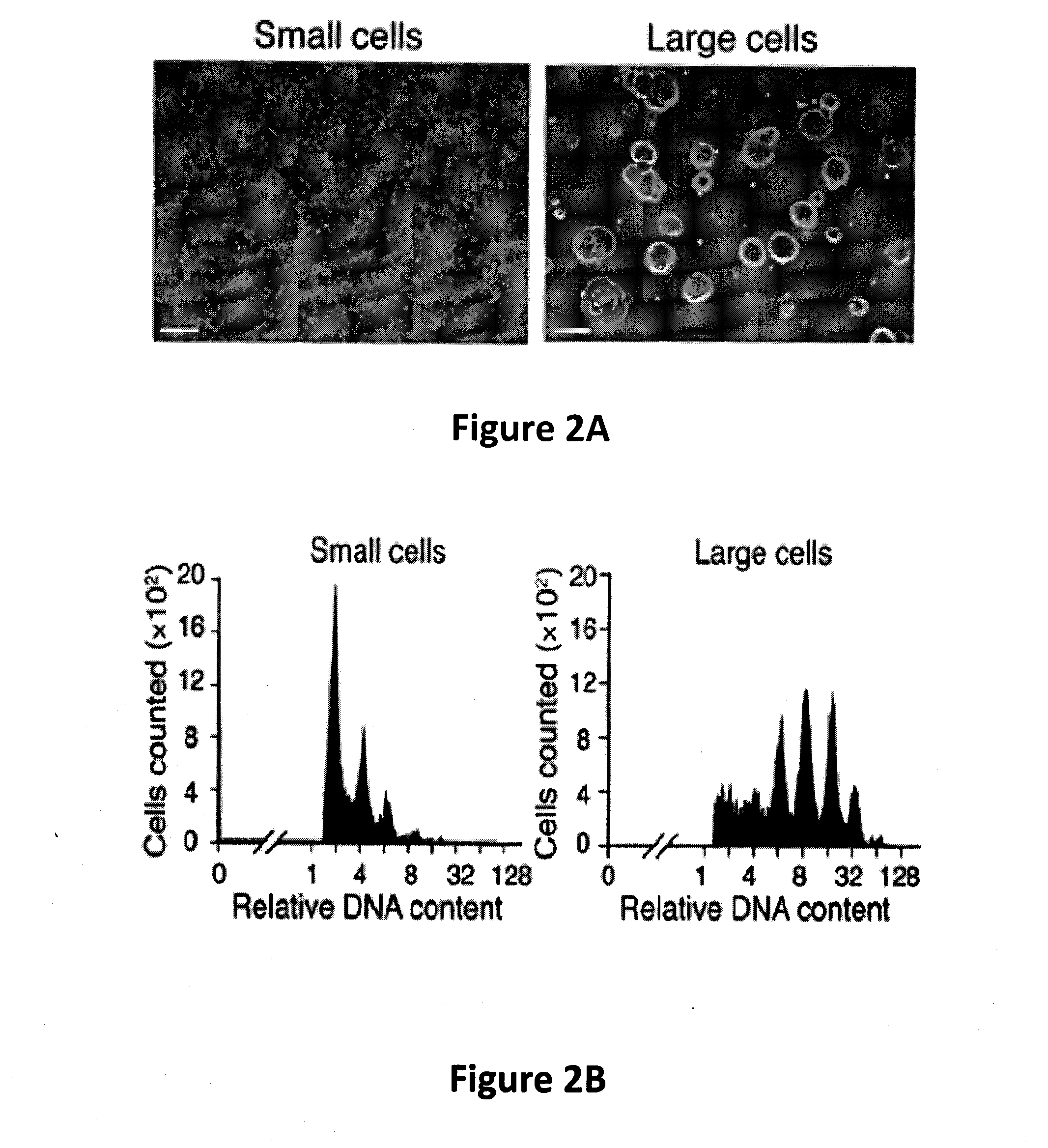Compositions and Methods for the Generation of Platelets and Methods of Use Thereof
a technology of platelet and composition, applied in the field of composition and method for the generation of platelets, can solve the problems of difficult quantitative upscale, still significant donor shortage, and the highest incidence of bacterial contamination in the unit, and achieve the effects of inhibiting thrombocytopenia in a subject, preventing thrombocytopenia, and decreasing the expression of gata-1
- Summary
- Abstract
- Description
- Claims
- Application Information
AI Technical Summary
Benefits of technology
Problems solved by technology
Method used
Image
Examples
example 1
Materials and Methods
Characterization of the Mice Studied
[0060]Donor cells and platelets were derived from C57BL / 6 WT mice (The Jackson Laboratory) or mUK-transgenic mice, which ectopically express murine urokinase within megakaryocytes (Kufrin et al. (2003) Blood 102:926-933). Recipient mice were homozygously transgenic for hαIIb and null for the expression of platelet mouse αIIb (mαII− / −) (Thornton et al. (2002) Blood 100:3588-3596), designated hαIIb+ mice, and expressed 20% of the level of CD41 seen on human platelets (Wagner et al. (1996) Blood 88:907-914.). All animal studies were done with approval of the Institutional Animal Utilization Committee at the Children's Hospital of Philadelphia.
Isolation of Platelets and Megakaryocytes Ex Vivo
[0061]Fetal liver (FL) megakaryocytes were obtained from E14 FL cells homogenized and cultured as previously described (Lecine et al. (1998) J. Biol. Chem., 273:7572-7578). Adult BM cells were obtained from femurs and tibiae of C57BL / 6 mice (S...
example 2
Establishing a Self-Replicating Murine MEP Cell
[0079]Murine GATA-1 null ES cells were created and used to show that the GATA-1 transcription factor is critical for both erythroid and megakaryocyte development (Shivdasani et al. (1997) EMBO J., 16:3965-73). Growth of these cells for 2 weeks in the presence of OP9 stromal feeder cells and thrombopoietin (TPO) led to a self-renewing cell line G1ME. Such a self-replicating cell line was not seen using wildtype (WT) ES cells of the same strain (Stachura et al. (2006) Blood 107:87-97). When transfected with a retrovirus that led to expression of both GATA-1 and green fluorescent protein (eGFP), ˜60% G1ME cells differentiated into megakaryocytes (GPIbα expression for mature megakaryoctes).
example 3
Generation of hESC-Derived Megakaryocytes
[0080]A 3-step embryoid body (EB)-based protocol in serum-free conditions to differentiate hESC lines into megakaryocytes has been used (French et al. (2007) Blood 110: Abstract 1265). Protocols for growth, maintenance, and differentiation of hESC lines have been described (Kennedy et al. (2007) Blood 109:2679-87). For differentiation to the megakaryocyte lineage, the following cytokines were used: BMP-4, bFGF and VEGF (all at 10 ng / ml); activin A (0.5-3.0 ng / ml); hSCF (100 ng / ml), hTPO (50 ng / ml), hEPO (2 U / ml), h1L-6 (20 ng / ml), h1L-3 (40 ng / ml), and h1L-11 (5 ng / ml). Using CD41 as an early marker of definitive hematopoiesis and CD42 (GP1b) as a megakaryocyte-specific marker, it was found that day 11 EB generated ˜10% CD41HiCD42+ and ˜20% CD41LoCD42± populations. Following cell sorting and culture in TPO-containing media, both populations underwent further differentiation as shown by increased CD41 and CD42 expression and by morphology (May...
PUM
 Login to View More
Login to View More Abstract
Description
Claims
Application Information
 Login to View More
Login to View More - R&D
- Intellectual Property
- Life Sciences
- Materials
- Tech Scout
- Unparalleled Data Quality
- Higher Quality Content
- 60% Fewer Hallucinations
Browse by: Latest US Patents, China's latest patents, Technical Efficacy Thesaurus, Application Domain, Technology Topic, Popular Technical Reports.
© 2025 PatSnap. All rights reserved.Legal|Privacy policy|Modern Slavery Act Transparency Statement|Sitemap|About US| Contact US: help@patsnap.com



